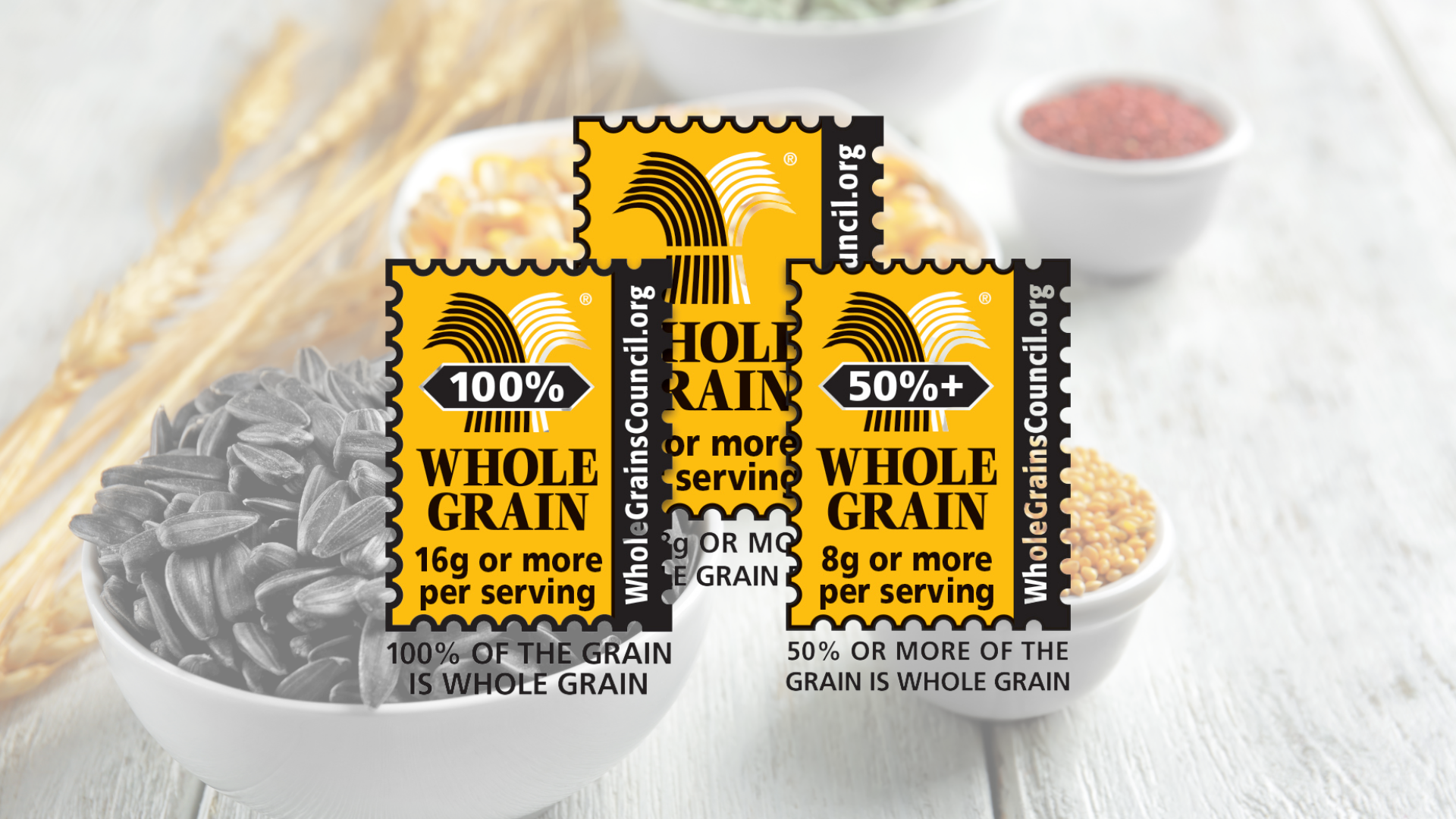Share This
To celebrate the 20th anniversary of the Whole Grain Stamp, we sat down with Cynthia Harriman, the founding director of the Whole Grains Council and architect of the Stamp! She shared stories and reflected on the lasting legacy of the Stamp.
WGC: Hi Cynthia! You started working at Oldways in early 2003, just after Oldways had organized the 10th Anniversary Mediterranean Diet Conference, where we had just begun our tiptoe into the world of whole grains. We’re curious what you remember doing to get the Whole Grains Council ball rolling, and what led up to the launch of the Whole Grains Stamp Program?
Cynthia: I started in March of 2003, but started is kind of a stretch because I was only working 10 hours a week. When we established the Whole Grains Council in July 2003 at the IFT (Institute of Food Technologies) conference, I had only worked 18 weeks, which is 180 hours, which is like four and a half weeks full time. I did not have a sense of where this was going to go!
We quickly figured out there were three things that we had to keep our eyes on to make the Whole Grains Council a robust and effective organization. First, we had the consumer side; how to figure out the best way to help consumers understand the health/taste benefits of whole grains and where to find them. Second, we had the manufacturer side. We had to figure out the best way to get food manufacturers on board by showing them that we could be a concrete benefit to business. Without proven benefits, neither business or consumers were going to get on board. The third part, of course, was the USDA and FDA. We had to figure out what we could do that would meet USDA and FDA regulations/guidelines. It’s was like a Venn Diagram; you have to figure out where the little place of overlap is, so you can actually do something that meets everybody’s needs. We had an early understanding that we needed a win-win on all of those.
WGC: At the IFT meeting, Oldways’ president Sara Baer-Sinnott remembered that you wanted to really define whole grains so that there was a standard that people were using; to make whole grains as mainstream as extra virgin olive oil was becoming; and then to get on Oprah. Can you tell us a little bit about each of these goals and how they were met?
Cynthia: The Oprah goal was more of an in-joke really when we started, “oh, we’ll just get on Oprah and then that’ll take care of spreading the word.” We didn’t make an active effort because we frankly had no idea how you could. I think at the time, they had something on their website saying don’t call us, we’ll call you if we’re interested. So, we put that aside for a while.
We concentrated on the first things; most importantly, how do you define whole grains? The packaging symbol was there from the start as a focal point these founding companies at IFT were interested in. Once we had a sense of what companies wanted, and what the FDA/USDA would allow, I went with a graphic designer friend to the grocery store and talked about what makes symbols pop out on the shelves, what colors would be best. We came up with the original Good Source, Excellent Source, and 100% Excellent Stamps, and introduced the Stamp at the first Whole Grains Conference in fall 2004.
You can imagine our surprise when shortly after, we received a call from Oprah. We thought it was a prank at first! The segment aired in May 2005, while we were all at IFT in Chicago. It certainly helped with recruiting companies to use the Stamp!
WGC: The Whole Grain Stamp was created to help consumers who were having trouble finding whole grains in grocery stores. What led you to identify that as one of the key barriers to whole grain consumption and recognize that a packaging label would be such a key part of promoting whole grains?
Cynthia: It was just common sense. If you’re going to get on your soapbox and say, “look for whole grains! They’re healthier and tastier!” The next question anybody’s going to ask is, “how will I know if I’ve found them?”
The Stamp was a perfect answer to that. It was an important way of bringing order to the wild west of spurious whole grain claims on packages. We wanted to build consumer trust and familiarity with whole grain products. It was the right moment in time to say this is how you will know that you have found a product that makes a substantial contribution to your whole grain consumption, and/or is 100% whole grain.
WGC: What were the biggest hurdles early on with the whole grain stamp? Was it design? Was it the regulatory issues you talked about? Was it acceptance or manufacturer acceptance?
Cynthia: Oh gosh, how much time do we have today? There was a hurdle around every corner, but it was fascinating because the upside is when you do something totally new like this, there’s no right way that you have to do it. On the other hand, there’s so many wrong ways you could do it and it’s easy to find them all. There were hurdles in every one of those three different constituency areas.
We needed to attract consumers, figuring out how to meet their needs and how keep them educated. We can still see in our regular WGC consumer surveys that this effort around education is important and ongoing. On the manufacturer side, we had to strike a balance between the companies that are already dedicated to whole grains and the ones that you can nudge up the ramp there. For regulatory, it was learning who had control over what. In general, the FDA has oversight of packaging, but if the product has meat in it, you have to go to USDA and they have different rules than FDA. You have to figure out how you meet all of these things at the same time.
It’s always important to remind both consumers and manufacturers that the Whole Grain Stamp is not a trademark, it is a certification mark. It has a special meaning in U.S. law, requiring that we must review submissions and ask any pertinent questions for products to qualify. It’s a vital distinction for consumers to understand how much more serious and solid the whole grain stamp is than most claims they see on packaging.
WGC: When do you think it was evident that the whole grain stamp was truly successful and what made you think so?
Cynthia: There are so many symbols that have come and gone over the years, but we’ve been had the WholeGrain Stamp consistently available to companies and familiar to consumers. Countless food fads have come and gone in the 20 years that the Stamp has been out there. The Whole Grains Council is so solid that, no matter what has been in food fashion, the Whole Grain Stamp is something that people can count on.
The international moments always stand out, like when I saw the Stamp in grocery stores everywhere, not just in the U.S. I was in Brazil for an Oldways’ conference, and went to the grocery stores and saw the stamp on products in Portuguese! I’d seen the products when they got approved, but it was completely different to be in another country and see it there. We also were approached by officials in China, who asked if we would advise them on promoting whole grains in China. We travelled there for a conference, and had a wonderful time.
WGC: What are you personally most proud of in your work on the Stamp?
Cynthia: Definitely knowing that there are consumers who have improved their diet because we have helped them find whole grains through the Stamp. I remember an early call I received from a man in the Midwest, looking for nutrition advice after his doctor told him to eat more whole grains. To picture that all over the country, there have been people like this guy who really wanted to take hold and improve his diet and had no idea where to start. We were there for him and all the others like him with the answers that would actually help them implement an idea. That’s what I’m most proud of.
WGC: Finally, how do whole grains fit into your daily life these days?
Cynthia: I’m not talking the talk anymore, but I’m still walking the walk. Most mornings I will either have steel cut oats, or I will have yogurt with berries and my homemade oat granola. Lunchtime is often something like hummus or peanut butter on a whole grain crisp bread. At dinner time, we’ll have brown rice or whole grain pasta with most meals, I also love wild rice and bulgur. I’m still dedicated to whole grains because I believe in not in just telling other people to eat whole grains—I really think they’ve helped me be healthy too.
To have our Oldways Whole Grains Council blog posts (and more whole grain bonus content!) delivered to your inbox, sign up for our monthly email newsletter, called Just Ask for Whole Grains.




Add a Comment